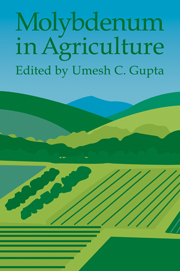Book contents
- Frontmatter
- Contents
- List of contributors
- Preface
- 1 Introduction
- 2 Chemistry and Mineralogy of Molybdenum in Soils
- 3 Distribution and Mobility of Molybdenum in the Terrestrial Environment
- 4 Biochemical Significance of Molybdenum in Crop Plants
- 5 Soil and Plant Factors Affecting Molybdenum Uptake by Plants
- 6 Analytical Techniques for Molybdenum Determination in Plants and Soils
- 7 Testing for Molybdenum Availability in Soils
- 8 Molybdenum Availability in Alkaline Soils
- 9 Deficient, Sufficient, and Toxic Concentrations of Molybdenum in Crops
- 10 Symptoms of Molybdenum Deficiency and Toxicity in Crops
- 11 Sources and Methods for Molybdenum Fertilization of Crops
- 12 Yield Responses to Molybdenum by Field and Horticultural Crops
- 13 Responses of Forage Legumes and Grasses to Molybdenum
- 14 Molybdenum and Sulfur Relationships in Plants
- 15 Molybdenum in the Tropics
- Index
5 - Soil and Plant Factors Affecting Molybdenum Uptake by Plants
Published online by Cambridge University Press: 10 December 2009
- Frontmatter
- Contents
- List of contributors
- Preface
- 1 Introduction
- 2 Chemistry and Mineralogy of Molybdenum in Soils
- 3 Distribution and Mobility of Molybdenum in the Terrestrial Environment
- 4 Biochemical Significance of Molybdenum in Crop Plants
- 5 Soil and Plant Factors Affecting Molybdenum Uptake by Plants
- 6 Analytical Techniques for Molybdenum Determination in Plants and Soils
- 7 Testing for Molybdenum Availability in Soils
- 8 Molybdenum Availability in Alkaline Soils
- 9 Deficient, Sufficient, and Toxic Concentrations of Molybdenum in Crops
- 10 Symptoms of Molybdenum Deficiency and Toxicity in Crops
- 11 Sources and Methods for Molybdenum Fertilization of Crops
- 12 Yield Responses to Molybdenum by Field and Horticultural Crops
- 13 Responses of Forage Legumes and Grasses to Molybdenum
- 14 Molybdenum and Sulfur Relationships in Plants
- 15 Molybdenum in the Tropics
- Index
Summary
Introduction
A number of factors can affect the availability of molybdenum (Mo) to crops. The most important ones include the nature of the parent rock, soil pH, the organic matter in the soil, drainage, interactions with other nutrients, and plant species, plant part, and stage of plant growth at sampling. This chapter attempts to review the information available on the soil and plant factors that affect Mo uptake by plants in different parts of the world.
Soil Factors
Molybdenum Occurrences in Parent Rocks
The concentrations and forms of Mo in rocks and soils tend to vary according to the particular origins and conditions of formation. Molybdenum is a versatile element insofar as valence is concerned, and it can precipitate under either oxidizing (Mo6+ predominant) or reducing (Mo4+) conditions (Manheim and Landergren, 1978). Consequently, there may be local enrichments or depletions, and recent work has largely been concerned with elucidating the sequences of occurrence, mobilization, and deposition in particular situations.
Occurrences in Igneous and Metamorphic Rocks
Igneous rocks make up some 95% of the crust of the earth (Mitchell, 1964), and Mo occurs in both acid and basic igneous rocks. Manheim and Landergren (1978) suggested an overall Mo content of nearly 2.0 ppm for granitic rocks and somewhat lower values for basalts.
Although the occurrences of Mo in metamorphic rocks have not been widely studied, metamorphism would be expected to alter the form and site of occurrence rather than the amount of Mo present.
- Type
- Chapter
- Information
- Molybdenum in Agriculture , pp. 71 - 91Publisher: Cambridge University PressPrint publication year: 1997
- 14
- Cited by



